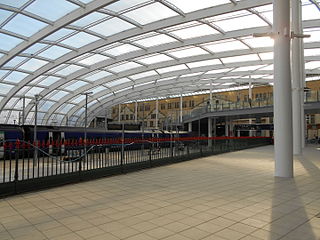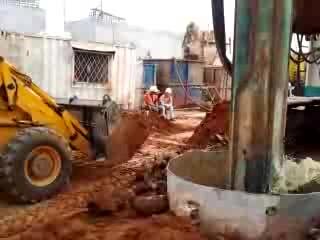

Dredge turning gland is a trailing suction hopper dredger component.


Dredge turning gland is a trailing suction hopper dredger component.
The dredge turning gland has a special particularity. Attached to the lower suction pipe the dredge turning gland allows a radial rotation in both directions of 15°. Due to this particularity the dredge turning gland enable the dredge drag head to follow the sea bottom without losing vacuum The dredge turning gland’s flanges are cast together with the body of the pipes and a rubber lip seal is used for the sealing of the dredge turning glands
Carbon steel and Carbon Manganese Steel are the Materials used for the production of pipe and flanges of the dredge turning glands. Cast iron is used for the production of the sliding pieces of the dredge turning glands.
A flange is a protruded ridge, lip or rim, either external or internal, that serves to increase strength ; for easy attachment/transfer of contact force with another object ; or for stabilizing and guiding the movements of a machine or its parts. Flanges are often attached using bolts in the pattern of a bolt circle.
A gate valve, also known as a sluice valve, is a valve that opens by lifting a barrier (gate) out of the path of the fluid. Gate valves require very little space along the pipe axis and hardly restrict the flow of fluid when the gate is fully opened. The gate faces can be parallel but are most commonly wedge-shaped.
A flow control valve regulates the flow or pressure of a fluid. Control valves normally respond to signals generated by independent devices such as flow meters or temperature gauges.

Dredging is the excavation of material from a water environment. Possible reasons for dredging include improving existing water features; reshaping land and water features to alter drainage, navigability, and commercial use; constructing dams, dikes, and other controls for streams and shorelines; and recovering valuable mineral deposits or marine life having commercial value. In all but a few situations the excavation is undertaken by a specialist floating plant, known as a dredger.

A hose is a flexible hollow tube designed to carry fluids from one location to another. Hoses are also sometimes called pipes, or more generally tubing. The shape of a hose is usually cylindrical.

An airlift is device based on a pipe, used in nautical archaeology to suck small objects, sand and mud from the sea bed and to transport the resulting debris upwards and away from its source. It is a type of suction dredge. A water dredge or water eductor may be used for the same purpose.
The Unified Numbering System for Metals and Alloys (UNS) is an alloy designation system widely accepted in North America. Each UNS number relates to a specific metal or alloy and defines its specific chemical composition, or in some cases a specific mechanical or physical property. A UNS number alone does not constitute a full material specification because it establishes no requirements for material properties, heat treatment, form, or quality.

Structural steel is a category of steel used for making construction materials in a variety of shapes. Many structural steel shapes take the form of an elongated beam having a profile of a specific cross section. Structural steel shapes, sizes, chemical composition, mechanical properties such as strengths, storage practices, etc., are regulated by standards in most industrialized countries.

A water eductor or water dredge is an eductor-jet pump-based tool used by underwater archaeologists to remove sediments from an underwater archaeological site. Airlifts may be used for the same purpose.

A fitting or adapter is used in pipe systems to connect sections of pipe or tube, adapt to different sizes or shapes, and for other purposes such as regulating fluid flow. These fittings are used in plumbing to manipulate the conveyance of fluids such as water for potatory, irrigational, sanitary, and refrigerative purposes, gas, petroleum, liquid waste, or any other liquid or gaseous substances required in domestic or commercial environments, within a system of pipes or tubes, connected by various methods, as dictated by the material of which these are made, the material being conveyed, and the particular environmental context in which they will be used, such as soldering, mortaring, caulking, plastic welding, welding, friction fittings, threaded fittings, and compression fittings.
ASTM A53 is a carbon steel alloy, used as structural steel or for low-pressure plumbing. The alloy specifications are set by ASTM International, in specification ASTM A53/A53M.

A deep foundation is a type of foundation that transfers building loads to the earth farther down from the surface than a shallow foundation does to a subsurface layer or a range of depths. A pile or piling is a vertical structural element of a deep foundation, driven or drilled deep into the ground at the building site.
A back-up ring is a rigid ring that holds an elastomeric seal or plastic connection to its designed shape and in its correct place. Back up rings are commonly used with O-rings, lip seals, and as reciprocating shaft seals. They are also used for piping connections joining two different materials - typically one flexible and one rigid.
Process duct work conveys large volumes of hot, dusty air from processing equipment to mills, baghouses to other process equipment. Process duct work may be round or rectangular. Although round duct work costs more to fabricate than rectangular duct work, it requires fewer stiffeners and is favored in many applications over rectangular ductwork.

Ductile iron pipe is pipe made of ductile cast iron commonly used for potable water transmission and distribution. This type of pipe is a direct development of earlier cast iron pipe, which it has superseded.
A dredge ball joint is a connection between two pipes that are used to transport a mixture of water and sand from a dredger to the discharging area.

A dredge drag head is used by a trailing suction hopper dredger to collect sand from the sea floor.

A trailing suction hopper dredger (TSHD) is a type of ship capable of maintaining navigable waterways, deepening the maritime canals that are threatened to become silted, constructing new land elsewhere or replacing sand eroded by storms or wave action on the beaches. This is made possible by large, powerful pumps and engines able to suck sand, clay, silt and gravel.

Dredge pipe pieces are a variety of pipes on board of dredgers like bend pipe, T-pipe, pitched T-pipe, Y-pipe, cross pipe, strait pipe, and conical pipe.

The Parflange F37 system is a technology from the hydraulic area of Parker-Hannifin, which allows a non welded flange connection of hydraulic tubes and pipes.